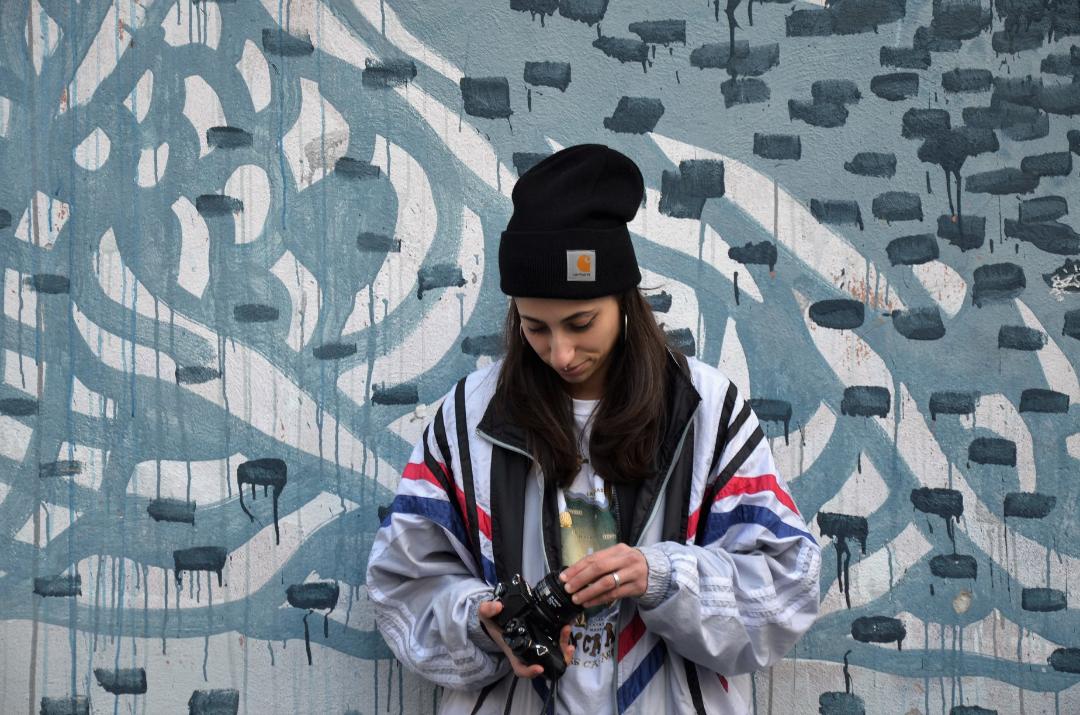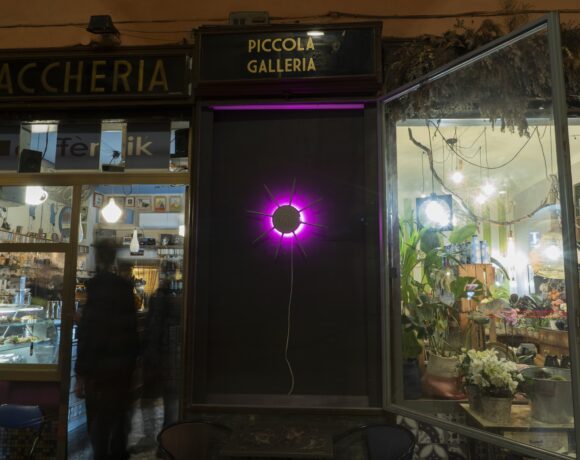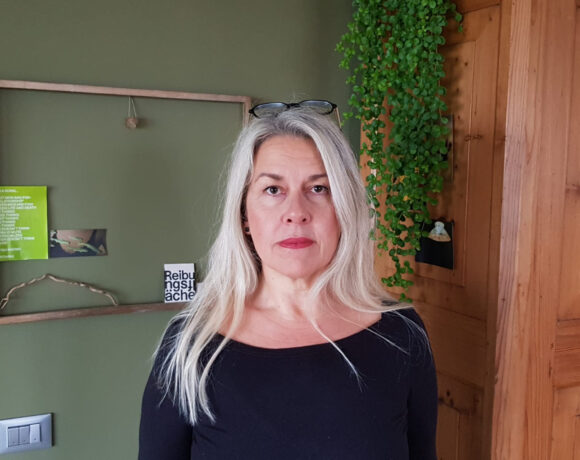The name Alchemilla, for those who live in Bologna, is now a certainty. Founded in 2017, the Association has established itself as one of the most innovative experimental and multipurpose reality in the city. The history of the project is also much more, as explained to me by Camilla Sanguinetti, one of the founders of Alchemilla that I had the pleasure of interviewing.

Yong Chung, Cuoghi Corsello, Alchemilla, 2019, installation view, ph. Rolando Paolo Guerzoni, courtesy Alchemilla
Sara Papini: How did Alchemilla’s project come about and what is its intent?
Camilla Sanguinetti: The principle of what then became the Alchemilla project was an experiment between friends carried out in 2017 in the spaces of a sixteenth-century building in the center of Bologna. The focus of the project was on a wall with a fresco dated at the end of the eighteenth century trompe-l’oeil located in the courtyard of the palace, around which, for one night, three different worlds were brought together: the enhancement of a historic palace such as Palazzo Vizzani, the scientific research of a PhD student from La Sapienza University in Rome and a site-specific artistic intervention. After a year, we organized Alchemilla, a group exhibition curated by Fulvio Chimento. Later came other ideas, such as using some spaces of the building to turn them into artist studios. At that time we had an apartment on the main floor that had been uninhabited for many years; we did not yet imagine what would happen next. So we gave space to other artist friends who had the need to experiment with projects that were also very different from each other, such as installations and tests of performative projects, up to meetings of research groups, but also lunches and dinners organized to compare. Over time, a heterogeneous community of people, different in age and training, has been created, which has nourished some common desires, such as having a reference place to work, exhibit and be together. At the end of 2019 we formed the Association, to give shape to our thinking and to find the necessary resources. The statute has required several months of preparation and the result is the result of reflections between people with different skills. In summary, Alchemilla is proposed as an interdisciplinary and multi-purpose cultural center, a place of experimentation, study, work and research, a place to meet and be together, an independent and non-profit space.

Roberto Fassone, Ai Lai, LZ, And We Thought III, installation view at Alchemilla, ph. Rolando Paolo Guerzoni, courtesy Alchemilla
Can you tell us about Alchemilla’s structure?
Alchemilla is composed of many different elements that live together and that often cross. The exhibitions – always with free admission – or the projects of residences continuously overlap, even if in different environments, to the activities of the studios, which instead take place throughout the year. To these are added other initiatives proposed by members or guest artists of Alchemilla, such as meetings or workshops, and the selection of projects by other artists, curators or critics and researchers or collaborations with other associations or informal groups and institutions. All this requires a precise but also flexible organization, which is planned but also has free time, where to cultivate a margin of unpredictability in which we recognize ourselves and we want to preserve, because it is related to the relationships between people and the exchange of ideas. Like the evolution of plants, also sensitive organisms, I hope that Alchemilla will develop following a widespread model of cohesion and cooperation between different species, which in my opinion can give shape to a much stronger and more stable social structure. There is still much to prove, but the idea is to continue working in this direction.

Alessandro Pessoli, City Of God, 2021, installation view at Alchemilla, ph. Rolando Paolo Guerzoni, courtesy Galleria Zero and Alchemilla
What can you tell us about the art residency program and future projects?
Before starting the Studio-Residency project, we wondered at length about the meaning we wanted to give to these residences. Once again we wanted to privilege the aspect of research and experimentation, relational and experiential, that artists can do by attending the spaces of Alchemilla. The residences are dedicated to Italian and foreign artists, under 35, working in the field of visual and performing arts. They are financed with the support of the Fondazione del Monte di Bologna e Ravenna and the Fondazione Zucchelli. The selection is made by direct call with the exception of the winners of the Zucchelli prize, selected from among the students of the Academy of Fine Arts in Bologna. The period of residence (which usually varies from two months to two weeks) ends with an event open to the public – an exhibition or a performance – or with an open test or a study visit dedicated to an audience made up of professionals. So far we have not felt the need to indicate the themes to be followed, because the main intent is to create the conditions for artists to work in a welcoming and stimulating environment with which to confront and where to freely insert their own research and visions. All our projects are documented thanks to the collaboration of Veronica Santi (critic and videomaker). For this year’s edition we hosted Edoardo Mozzanega (dancer and choreographer) and Chiara Prodi (artist and dancer), with the project Dream of a Tiger, in June instead it will be the turn of the winner of the Zucchelli award (not yet proclaimed) and that will be curated by Tatiana Basso, while in the autumn we will host Enej Gala, Slovenian artist who works between London, Venice and Nova Gorica, curated by Enrico Camprini. For 2024 there will probably be only two residences, one with Julia Carrillo, an interdisciplinary artist from Mexico City, while the other will be awarded to the winner of the Zucchelli Prize 2024.

Mattia Pajè, Fuori Terra, 2022, installation view at Alchemilla, ph. Carlo Favero, courtesy Alchemilla
What is your role as founder in this project?
It’s a very difficult question, the first image that comes to mind is again that of Alchemilla as a plant and of me as a gardener who has sown it and now takes care of it. If now this plant is growing well it is also thanks to the soil we found in Bologna, fertile and full of energy, and then there are plants around us, many realities and people who in recent years have been a source of great inspiration and support. If I think about it better, I could also give you other, more rational answers, regarding my direct involvement with this building, owned by my family, where I was born and where I returned about twelve years ago. I also had to refer to my education related to architecture and urbanism and how these aspects allowed me to bring art back to a place where it had always been. Sometimes I thought that Cardinal Lambertini who built the portion of the palace where we are, would be happy to see us at work in these rooms and, in doing so, a historic building like this maintains its meaning in the world today.
Sara Papini
Info:
Alchemilla,
Via Santo Stefano 43, Bologna

She was born in Genoa but currently lives in Bologna, the city where she graduated from CITEM with a thesis on video art. She works in the world of events in the production sector and is an assistant professor of Visual Studies at UNIBO.






NO COMMENT